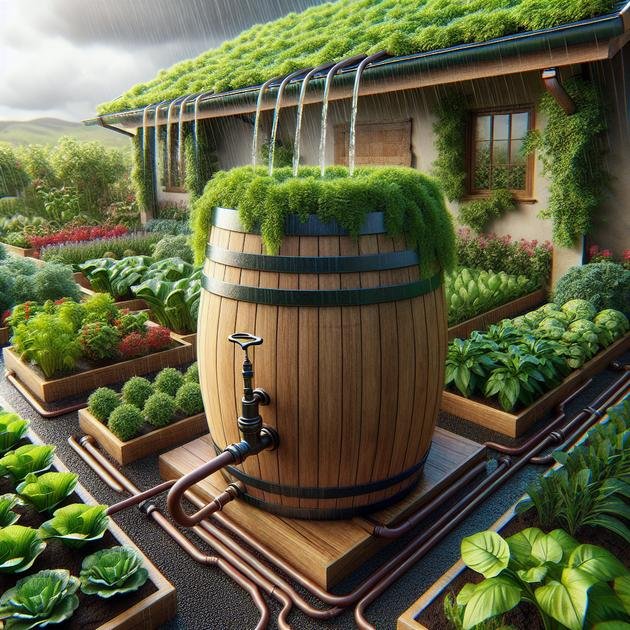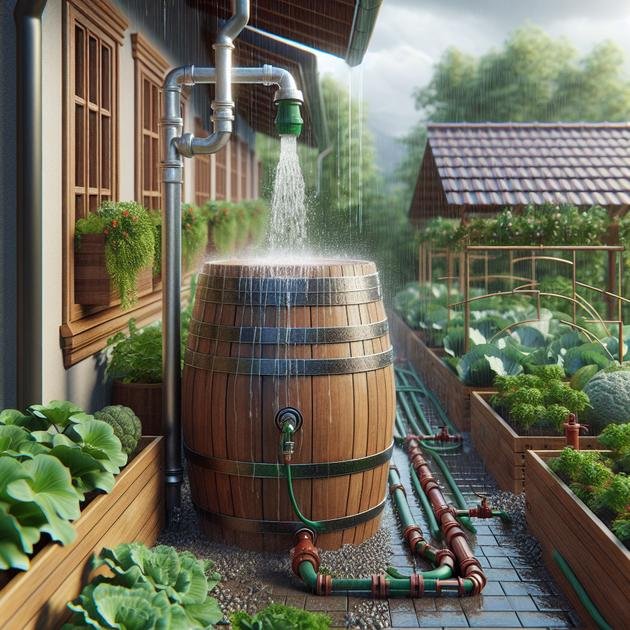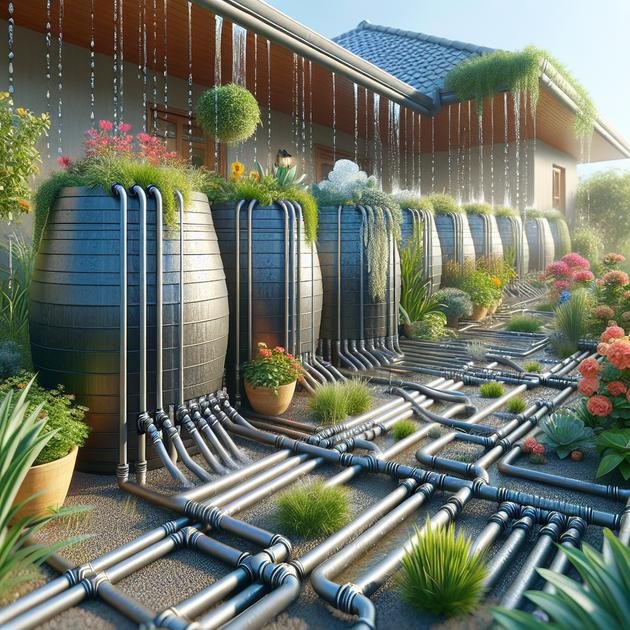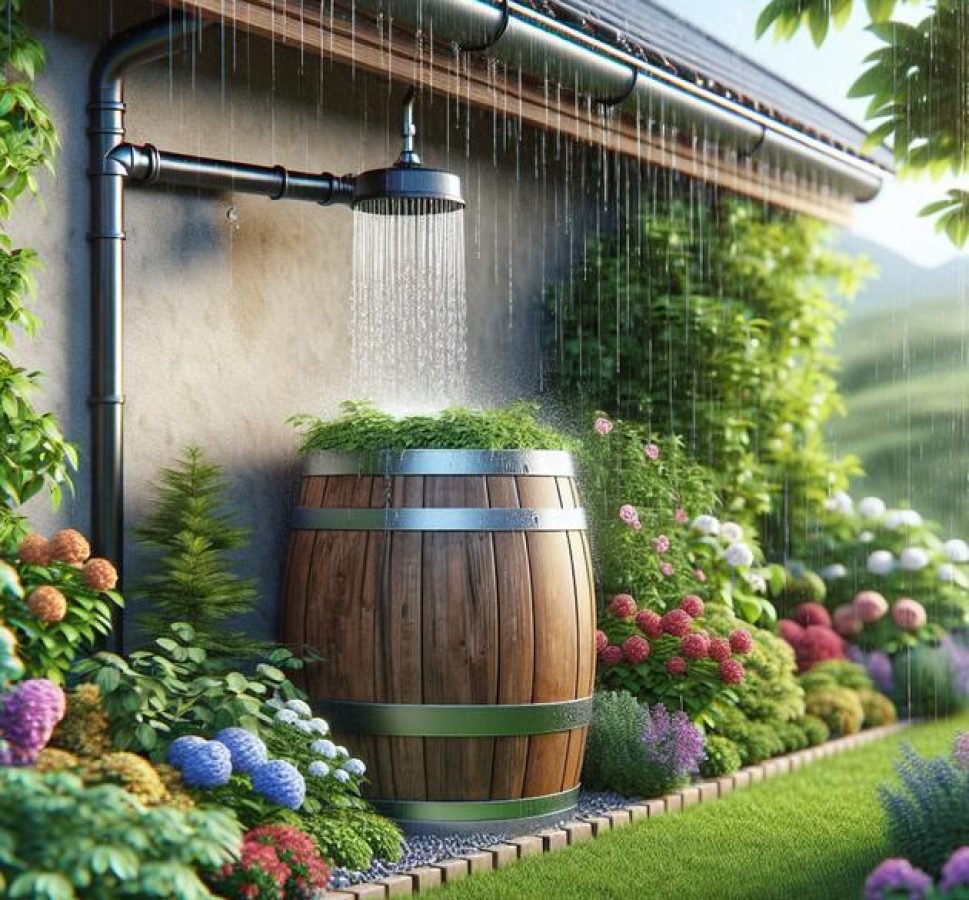Rainwater harvesting garden involves collecting and using rainwater through systems like rain barrels and cisterns to conserve water, support plant health, reduce water bills, and promote sustainable gardening by efficiently managing water throughout the seasons.
Have you thought about how rainwater harvesting garden can change your approach to watering plants? It’s a clever way to save water and keep your green space thriving, especially if you want a more natural and sustainable garden. Let’s explore how it works and how you might get started.
why rainwater harvesting matters for your garden
Harvesting rainwater for your garden is an important practice that helps conserve water and supports sustainable gardening. By collecting rainwater, you reduce reliance on municipal water supplies, which is especially valuable during dry periods or droughts. Using rainwater also avoids the chemicals and additives often found in tap water, making it healthier for your plants.
Environmental Impact
Rainwater harvesting decreases stormwater runoff, reducing soil erosion and water pollution in local waterways. It also lessens the demand on sewer systems during heavy rains, preventing flooding and water contamination. By relying on natural rainfall, you contribute to a greener environment and help protect ecosystems.
Cost Savings and Efficiency
Using harvested rainwater lowers your water bills significantly. Once set up, a rainwater harvesting system requires minimal maintenance but offers ongoing benefits. It provides a free water source for your garden, which can be especially useful for large gardens or landscapes.
Plant Health Benefits
Rainwater is naturally soft and free from salts and chemicals, making it ideal for watering a wide range of plants. It promotes healthier growth and can improve soil quality over time. Many gardeners notice better results when using rainwater compared to tap water.
Overall, rainwater harvesting for your garden is a simple, effective way to save resources, improve plant health, and support a sustainable lifestyle.
choosing the right rainwater harvesting system
Choosing the right rainwater harvesting system depends on your garden’s size, local climate, and available space. There are several options, ranging from simple rain barrels to more complex underground tanks. Assessing your needs helps identify the most efficient and cost-effective system for your situation.
Types of Systems
Rain barrels are the most common and affordable choice, suitable for small to medium gardens. They are easy to install and maintain. Larger gardens or those with higher water demands might benefit from cisterns or underground storage tanks, which can store more water and reduce evaporation.
Material Considerations
Systems are typically made from plastic, metal, or concrete. Plastic is lightweight and affordable, while metal options can be more durable but prone to rust. Concrete tanks offer long-term durability but can be costly and harder to install.
System Components
When choosing a system, consider additional components like first flush diverters, which keep debris and contaminants out of your storage, and filters that ensure clean water for your plants. A secure lid is important to prevent mosquito breeding and contamination.
Ultimately, the best system balances capacity, cost, maintenance, and your specific garden needs to maximize the benefits of rainwater harvesting.
how to set up a rain barrel step-by-step
Setting up a rain barrel is a simple and effective way to start harvesting rainwater for your garden. Begin by selecting a sturdy barrel with a tight-fitting lid to keep debris and insects out. Position the barrel near a downspout to capture water from your roof gutters.
Step 1: Prepare the Location
Choose a level area to place the barrel, preferably elevated on concrete blocks or a stand. Elevation helps improve water flow and makes it easier to access the spigot.
Step 2: Modify the Downspout
Cut the downspout so it directs water into the barrel. You may need to attach an elbow or diverter kit to help guide the flow properly.
Step 3: Install the Spigot and Overflow
Attach a spigot near the bottom of the barrel for easy water access. Also, install an overflow outlet near the top to divert excess water away from your foundation during heavy rains.
Step 4: Add a Screen or Filter
Place a fine mesh screen over the barrel’s opening to filter out leaves, insects, and other debris. This keeps the stored water clean and prevents mosquito breeding.
By following these steps carefully, you can set up a functional rain barrel that harvests water efficiently and supports your garden’s health throughout the seasons.
materials needed for a rainwater harvesting garden

Creating a rainwater harvesting garden requires several key materials to set up an effective system. A reliable rainwater collection container, such as rain barrels or cisterns, is essential to store the water. Gutters and downspouts direct rainwater from roofs toward your storage system.
Collection Components
You’ll need gutters to catch and guide the rainwater, typically installed along your roof’s edge. Downspouts connect gutters to your storage containers, ensuring water flows efficiently. Using a first flush diverter can help divert the initial dirty runoff away from your storage tank.
Storage and Distribution
Your storage container should have a secure lid to prevent debris and insects from entering. Installing a spigot or faucet near the bottom helps you access the water. For larger gardens, you may want pumps or irrigation systems to distribute water effectively.
Filtration and Maintenance
Incorporate screens or leaf guards to filter out leaves and dirt. Regular maintenance tools like brushes and hoses will keep your system clean and functioning well. Proper materials and setup ensure your rainwater harvesting garden remains efficient and sustainable.
best locations for collecting rainwater
Selecting the best location for collecting rainwater is key to maximizing the efficiency of your harvesting system. The ideal spots are typically near roof downspouts, where water naturally drains during rainfall. Positioning your storage container close to a downspout minimizes water loss and ensures a steady flow.
Consider Elevation and Accessibility
Place the rainwater collection system on a level area that is slightly elevated using stands or blocks. This makes accessing the water easier and helps with gravity-fed irrigation systems. Also, ensure the spot is easy to reach for maintenance and water collection.
Avoid Contaminated Areas
It’s important to choose locations away from sources of contaminants like overhanging trees that drop leaves, or areas prone to animal droppings. This helps keep your collected water cleaner and safer for your plants.
Sunlight and Space
While direct sunlight doesn’t affect rainwater collection, storing your containers in shaded areas can reduce algae growth inside the barrels. Make sure there is enough space around the system for regular cleaning and repairs.
Overall, the right location supports efficient water harvesting and long-lasting system performance for your rainwater harvesting garden.
maintaining your collection system for peak efficiency
Regular maintenance is essential to keep your rainwater collection system running efficiently. Start by inspecting gutters and downspouts to ensure they are free of leaves, dirt, and debris that can block water flow.
Cleaning and Inspecting the Storage
Check your storage containers, such as rain barrels, regularly for algae growth, sediment buildup, or cracks. Clean the inside of the container at least once or twice a year to maintain water quality. Use a scrub brush and mild detergent to remove any buildup.
Maintain Filters and Screens
Filters, screens, and first flush diverters need routine checks to make sure they are not clogged or damaged. These components prevent contaminants from entering the storage system and help keep water clean.
Prevent Mosquito Breeding
Ensure that lids are always securely closed and that screens are intact to stop mosquitoes from breeding in your barrels. Consider adding mosquito dunks or other natural insect controls if necessary.
By staying on top of these tasks, you ensure your rainwater harvesting system remains efficient and reliable for your garden’s needs.
using rainwater for different types of plants
Rainwater is an excellent resource for watering different types of plants, as it is free from chemicals like chlorine and fluoride commonly found in tap water. However, different plants have varying water needs, and understanding these needs will help you use rainwater most effectively.
Watering Vegetables and Herbs
Vegetable gardens and herbs generally appreciate consistent moisture but do not like to be waterlogged. Use rainwater to soak the soil deeply once or twice a week, depending on the weather. This encourages healthy root growth and nutrient uptake.
Flower Beds and Ornamental Plants
Most flowering plants thrive with rainwater because it is softer and less alkaline. Water these plants with rainwater in the early morning or late evening to reduce evaporation. Deep watering once or twice a week is usually sufficient.
Shrubs and Trees
For larger plants like shrubs and trees, rainwater can be used to supplement natural rainfall during dry periods. Focus on watering at the base to encourage deep root growth. Mulching around the plants also helps retain moisture.
Houseplants and Sensitive Species
Many houseplants and sensitive species especially benefit from rainwater since it is gentle and avoids mineral buildup. Use filtered rainwater when possible, and avoid watering leaves directly to prevent fungal diseases.
Understanding the water needs of your plants and using rainwater appropriately can improve plant health and conserve water resources in your garden.
tips to prevent mosquito breeding in rain barrels

Mosquito breeding in rain barrels can be a common problem, but it is preventable with simple steps. Standing water is the key factor that allows mosquitoes to lay eggs, so keeping your rain barrel sealed and clean is essential.
Seal the Barrel with a Tight Lid
Always ensure your rain barrel has a tight-fitting lid or screen to prevent mosquitoes from entering and laying eggs. Repair any holes or gaps immediately.
Use Fine Mesh Screens
Cover the barrel’s openings and overflow outlets with fine mesh screens. These keep mosquitoes out while allowing water to flow freely.
Regular Cleaning
Clean your rain barrel regularly to remove mosquito eggs and larvae. Scrub the inside walls with a brush and rinse thoroughly.
Apply Natural Mosquito Controls
Consider adding mosquito dunks containing bacteria that target mosquito larvae but are safe for plants and pets. This biological control helps keep your water safe and usable.
Maintain Water Movement
Keeping water moving by using a drip irrigation system or a fountain attachment can discourage mosquito breeding since mosquitoes prefer stagnant water.
By following these tips, you can protect your rainwater harvesting garden from mosquito problems and enjoy cleaner, safer water.
integrating rainwater harvesting with garden irrigation
Integrating rainwater harvesting with your garden irrigation system maximizes water efficiency and supports sustainable gardening practices. Connect your rainwater storage directly to drip irrigation or soaker hoses for precise watering of plants and reduced water waste.
Connecting Rain Barrels to Irrigation
You can install a pump or gravity-fed system to deliver rainwater from your storage barrels into your irrigation lines. Gravity systems require elevating barrels, while pumps offer more flexibility in placement.
Using Timers and Sensors
Pairing your irrigation system with timers or moisture sensors helps automate watering schedules based on plant needs, conserving water by avoiding overwatering.
Benefits for Plant Health
Using rainwater directly supports plant health by providing soft, chemical-free water. This can reduce leaf damage and enhance soil quality. It also lowers your municipal water use, saving money and reducing environmental impact.
Proper integration ensures your rainwater harvesting garden uses collected water efficiently, promoting lush and healthy growth with minimal waste.
how to handle excess rainwater during heavy storms
Heavy storms can produce more rainwater than your harvesting system can handle. Managing this excess water is crucial to prevent damage and overflow. One effective method is installing overflow outlets that divert surplus water safely away from your foundation and garden.
Installing Overflow Pipes
Attach overflow pipes near the top of your rainwater storage containers. These pipes should lead to a safe drainage area such as a dry well, rain garden, or storm drain, preventing flooding around your home.
Creating Rain Gardens
Rain gardens are shallow depressions planted with water-loving plants. They naturally absorb and filter excess rainwater, reducing runoff while beautifying your landscape.
Using Permeable Surfaces
Incorporate permeable materials like gravel or porous pavers around your harvesting system to facilitate water infiltration into the soil, reducing surface runoff.
Regular System Checks
Ensure gutters and downspouts are clear before storm seasons. Debris can block water flow and worsen overflow problems during heavy rains.
Managing excess rainwater wisely ensures your rainwater harvesting garden stays protected and sustainable even in heavy storms.
legal considerations and local regulations
Before setting up a rainwater harvesting system, it’s important to understand the legal considerations and local regulations that may apply in your area. Some regions have restrictions or specific requirements for collecting and using rainwater.
Check Local Laws
Research your city, county, or state regulations about rainwater harvesting. Some places encourage it through incentives, while others may limit the amount you can collect or require permits.
Permits and Approvals
In some jurisdictions, installing rain barrels or larger collection systems requires permits or inspections. Make sure to acquire any necessary permissions before beginning installation to avoid fines.
Use Restrictions
Be aware of restrictions on how harvested rainwater can be used. Some areas allow rainwater only for irrigation, while others may permit its use for indoor non-potable tasks.
Water Rights and Sharing
Understand if there are water rights involved that could affect your ability to collect rainwater, especially in regions where water is scarce or controlled. Sharing water or connecting to municipal systems might have legal implications.
Following local rules ensures your rainwater harvesting garden remains compliant and contributes positively to water conservation efforts.
environmental benefits of harvesting rainwater

Harvesting rainwater offers numerous environmental benefits that contribute to sustainable living. Collecting and using rainwater reduces the demand on municipal water supplies and helps conserve natural freshwater resources.
Reducing Stormwater Runoff
Rainwater harvesting decreases stormwater runoff, which can carry pollutants into rivers and lakes. By capturing rainwater, you reduce erosion and protect water quality in local ecosystems.
Lowering Energy Use
Using rainwater cuts down on the energy needed to treat and pump municipal water. This reduces your carbon footprint and contributes to cleaner air.
Supporting Plant Health
Rainwater is free from chemicals like chlorine and fluoride, making it healthier for plants. Using natural rainwater promotes better growth and soil health in your garden.
Encouraging Water Conservation
Harvesting rainwater raises awareness about water use and encourages conservation habits, helping communities adapt to climate change and drought conditions.
Overall, integrating rainwater harvesting into your gardening practices supports the environment by preserving water quality, conserving resources, and promoting healthier plants.
costs and savings: is it worth the investment?
Investing in rainwater harvesting can lead to significant long-term savings, but it requires an initial cost for setup. These costs vary depending on the system size, materials, and complexity.
Initial Setup Costs
The price of rain barrels, cisterns, pumps, and additional accessories like filters or diverters can range from modest to substantial, depending on your garden’s size. Installation costs might also apply if hiring professionals.
Ongoing Maintenance Expenses
Maintaining a rainwater harvesting system includes occasional cleaning, repairs, and replacement of parts like screens or pumps. These costs are generally low but necessary to keep the system efficient.
Water Bill Savings
Using harvested rainwater reduces dependence on municipal water, resulting in lower monthly water bills. The amount saved depends on local water rates and your garden’s water needs.
Environmental and Social Value
Beyond financial aspects, investing in rainwater harvesting supports environmental conservation and sustainability, which adds intangible value to your property and community.
Overall, while upfront costs exist, the savings and environmental benefits of rainwater harvesting often make it a worthwhile investment, especially in areas facing water scarcity or high water prices.
common mistakes and how to avoid them
Many beginners face common mistakes when setting up rainwater harvesting systems. Recognizing and avoiding these errors can save time and money while improving system efficiency.
Improper Placement of Collection Containers
Placing barrels or tanks on uneven or unstable ground can cause tipping or inefficient water capture. Always choose a level surface and consider elevating containers for better water pressure.
Neglecting Maintenance
Failing to clean gutters, screens, and storage tanks can lead to clogged systems, poor water quality, and mosquito breeding. Regular inspection and cleaning are essential.
Ignoring Local Regulations
Setting up a system without checking local laws can result in fines or forced removal. Ensure you understand the legal requirements before installation.
Using Untreated Rainwater Improperly
Using rainwater without proper filtration or treatment for sensitive plants or indoor use can harm plant health or pose risks. Employ appropriate filters and use water correctly.
Choosing the Wrong System Size
Oversized or undersized systems won’t be efficient. Analyze your garden’s water needs and rainfall patterns to select the right capacity.
By avoiding these common pitfalls, you can ensure your rainwater harvesting garden functions well and provides sustainable benefits for years to come.
seasonal adjustments for your rainwater system
Seasonal changes require adjustments to your rainwater harvesting system to maintain efficiency and protect your investment. Each season presents unique challenges that affect water collection and storage.
Spring Preparation
Inspect gutters and downspouts for winter debris. Clean and repair any damage to ensure smooth water flow. Test your storage tanks and clean them to remove sediment buildup.
Summer Maintenance
Monitor water levels as rainfall may decrease. Consider covering barrels with UV-resistant lids to prevent algae growth. Check for leaks or cracks due to heat exposure.
Fall Cleaning
Clear gutters of fallen leaves and debris to avoid clogs. Drain or disconnect your system if necessary to prepare for freezing temperatures. Remove and store hoses to prevent damage.
Winter Protection
Empty storage tanks to prevent freezing and cracking. Insulate exposed pipes and containers where possible. Keep lids secure to prevent debris and animals from entering.
Adapting your rainwater harvesting garden system with seasonal care ensures longevity and consistent water supply throughout the year.
Wrapping Up Your Rainwater Harvesting Garden
Setting up and maintaining a rainwater harvesting garden is a smart way to save water, support your plants, and care for the environment. By choosing the right system, adjusting it each season, and avoiding common mistakes, you’ll enjoy a sustainable and efficient garden all year round.
With a little effort and attention, rainwater harvesting can reduce water bills and provide healthier water for your plants. Start small, learn as you go, and watch your garden thrive with natural rainwater.
Remember, every drop counts, and your efforts make a difference for your garden and the planet.





